This article came to us via a friend in the USA from a friend in Greece!
Orignal article by Mary Adamopoulou
An old warehouse of a few square meters in the chapel of Osia Xeni, next to the station of ISAP Kato Patissia, filled the period of the first quarantine with saints bearing strange names and surrounded by animals and birds!
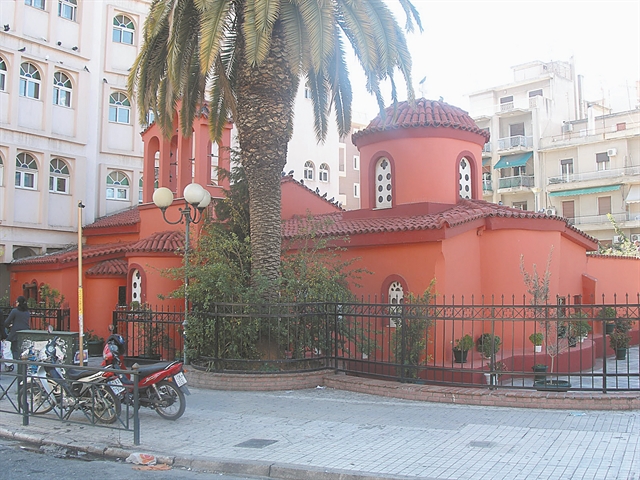
The chapel of Osia Xeni, next to the station of ISAP Kato Patissia
Afew months ago, while I was facing a serious health problem in my close family environment, a friend, in an attempt to reassure me, told me: “It’s going to be okay. I’ll stop by St. Kevin’s and light a candle.” At first I didn’t pay attention. I thought I was disobeying my agitation. But when the problem was overcome, I calmly recalled our discussion and came back asking for clarification. “Who’s St. Kevin?”
The appointment was given a few days later, on Acharnes Street, next to the kato patissia power station. Just a few metres away, among dozens of barber shops run by migrants, small and larger grocery stores with delicacies from the Arab world and countries in the former eastern bloc and restaurants with dishes from Iran to Russia, a chapel is displayed. Ceramic red, with a triple bell tower and a small courtyard full of flowers that would be more suited to the environment of an island than to the grey and concrete urban fabric.
An improvised sign at the entrance welcomes us to the chapel of Osia Xeni, which is a metochi of Agios Nikolaos Syros. And since he urges us to take all necessary means of protection for the pandemic, he invites us to meet the chapel with the Celtic saints. A chapel that counts only a few months of life as its canonization was completed during the first period of confinement, last spring.
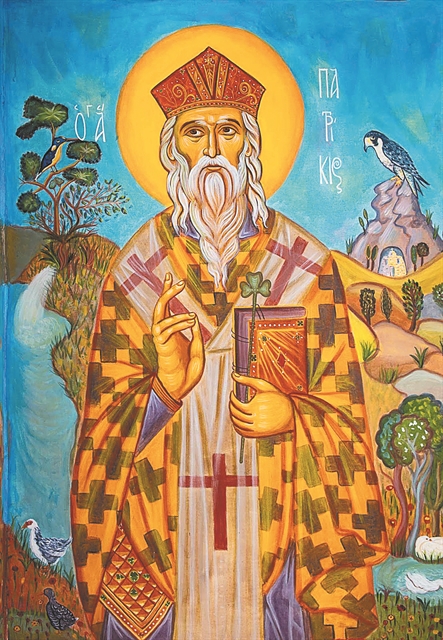
At first glance nothing seems strange in the chapel. Believers worship and light a candle. The well-known saints adorn the walls. By the time the gaze falls on an opening in the middle of the temple, on the right. “Guardians” of the entrance on either side the Saints Panteleimon and Charalambos. Among them, the inscription “Holy chapel of Celtic saints”.
Just three square meters, chock full of 21 saints, whose names in most of us are more reminiscent of actors of cinema and in no (rather) case saints, and indeed of Orthodox doctrine.
St. Kevin’s, St. Alban’s, St. Bridgend, St. Hilda’s, St. Brendan’s… All of them small, strict in appearance, most with a sympathetic look and several of them surrounded by animals: dolphins, hares, blackbirds.
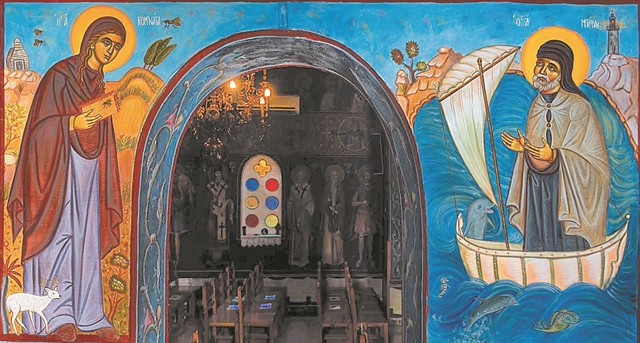
“It is the first place in Athens dedicated to the Celtic Orthodox saints (p.p.: another chapel dedicated to these saints exists in the retreat of St. Porphyri in Melesi Attica) and could not be found a better hostess than Osia Xeni to embrace “foreign” saints” says in “NEA” the vicar, Father Georgios Ganotis, who does not only work in a church with “foreign” saints , but also in a neighborhood full of immigrants from every corner of the planet.
The chapel of the Celtic saints until about a year ago was nothing but a warehouse, in a miserable state, as he describes us, with candles that smelled and no one wanted or dared to pull the curtain covering its entrance. “Today it is a gem that combines beauty with knowledge,” he says proudly.
But who are these Celtic saints? They are saints who lived in the early centuries when Christianity arrived in Britain, Wales, Ireland. They were then lost after the roman Catholic Church and Protestantism prevailed in these areas, when many monasteries were destroyed, while the remains of the saints were even used to make mandre.
St. Kevin’s
St. Kevin, one of Ireland’s most important saints, for example, lived in the 6th century. and came from a family of the royal generation, as we read in the edition “The Celtic saints in the chapel of Osia Xeni” available only from the temple. He lived like a hermit in the Valley of the Two Lakes, near Dublin, was associated with nettles and was particularly well-groomed. In fact, an otter was once said to have brought him the manuscript of the psalms that fell on him in the lake, became friends and fished on his behalf. He is pictured holding a nest of blackbird chicks in his right hand, as he is said to have held their nest in his hand for days, motionless, until the blackbird threads its eggs and feeds the cubs so they can fly.
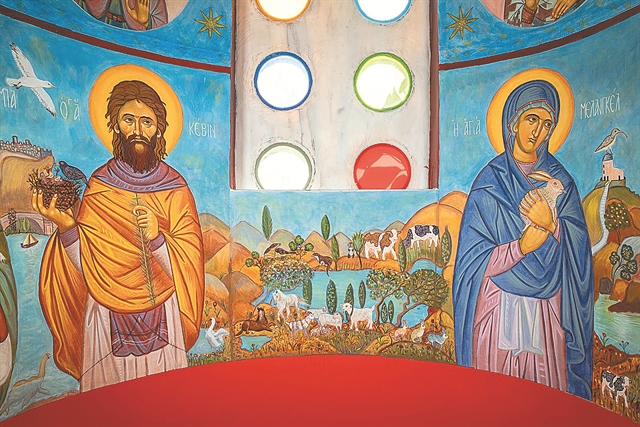
Saint Bridgeid asked Christ to make her ugly so that no one would want to marry her so that she could be insulated. Her wish came true, but in time she regained her natural beauty and reportedly performed a multitude of miracles forming only the spot of the cross. It is also due to the crosses of reeds – popular in Greece – for protection from evil. St. Brendan, although to some he is known as the fictional character of the play “Brendan’s Journey”, was born in the late 5th century BC. in Ireland and in addition to the fact that he founded many monasteries in his homeland, Wales, Scotland and France, he may have done a great sea exploration that led him to the shores of North America, hence he is depicted on a ship in the company of dolphins and other living beings of the sea. Saint Hilda who lived in the 7th century. they consulted kings, princes and bishops of England as they considered her the spiritual mother of the country.
Among them is a well-known saint to all, even today: St. Patrick, the Scottish missionary who taught Christianity in Ireland. In his youth and a prisoner of pirates, he managed to escape and then became a missionary teaching the mystery of the Holy Trinity using as an example the clover which, although composed of three parts, is a plant.
One of the questions that arises is that, since these saints are largely unknown, how did the defendant of the Holy Monastery of Panagia Vryoulon of the Holy Archdiocese of Athens, Gerontissa Philothei, manage to create the 21 hagiographies that adorn the chapel? “It wasn’t easy. I relied on information from the co-rooms and used my imagination. Hagiography is not a copy paste. Many times out of ignorance and fear we proceed to sterile copies so as not to attribute elements that do not match the Orthodox spirit. But if we observe the Byzantine hagiographers, we will find that they have been bold”, explains the abbot, who has been involved in hagiography for the last 22 years and while she had no contact with either painting or hagiography until her acquaintance with her teacher, priest Stamatis Skliris.
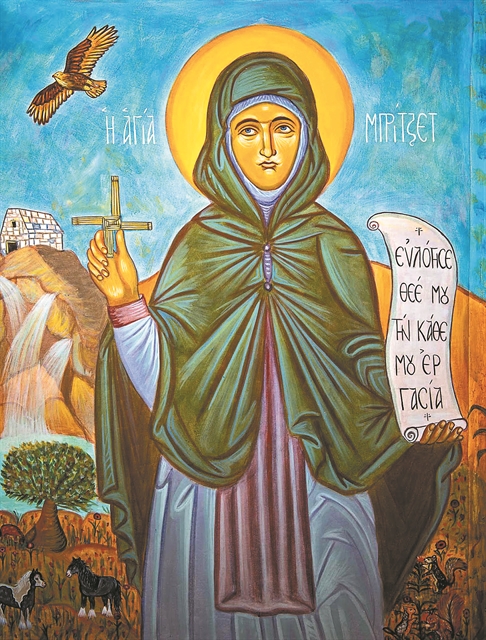
From the creation of the drawings to the completion of the project, gerontissa Philothei took about a year and a half and worked with hagiography powders and glue. The difficulties were not lacking, as he tells us, when moisture problems on the roof caused the angels he had painted to fall and had to be repositioned.
The idea for the canonization of the chapel belongs to the philologist Konstantinos Ganotis (father of the vicar), who knew about the Celtic saints through his spiritual father St. Porphyrios. The latter even said that “when the Greeks discover the Celtic saints, the Anglicans will become Orthodox”.
But why did the unknowns even in the ecclesiastical circles of Celtic saints occupy a place in a temple in the heart of Athens? “We are not only interested in making these saints known in the world, but in showing the universal character of Orthodoxy. Many times we have a localistic approach, we believe that our religion concerns the Mediterranean basin and we do not realize that we are part of a larger puzzle. When you discover foreign saints, you discover that the Church is a global affair. Universal. And you understand that the saints are not our handlers and that the Church is not in our pocket,” explains Father Georgios Ganotis, who admits that the reception of these saints was initially restrained by the faithful. “But as time goes by, they worship and are interested in learning about the saints who lived so far from our land. Children come who want to see the animals as almost all these saints had a special relationship with the animals, they were nature lovers. They’re buying the book we’ve published to get more information. They approach the chapel as a part of the temple they already love,” he concludes.
